Key takeaways:
- Anti-war activism goes beyond protests; it involves advocating for human rights and understanding the socio-political factors driving conflict.
- Finding and sharing your voice in activism fosters authenticity and empowers others to speak out about their experiences with war.
- Engaging with local communities and listening to personal stories deepens understanding and commitment to advocacy, highlighting the importance of unity and compassion.
- Making a tangible impact requires not just words but actions, such as organizing events and leveraging digital platforms to amplify voices and inspire change.
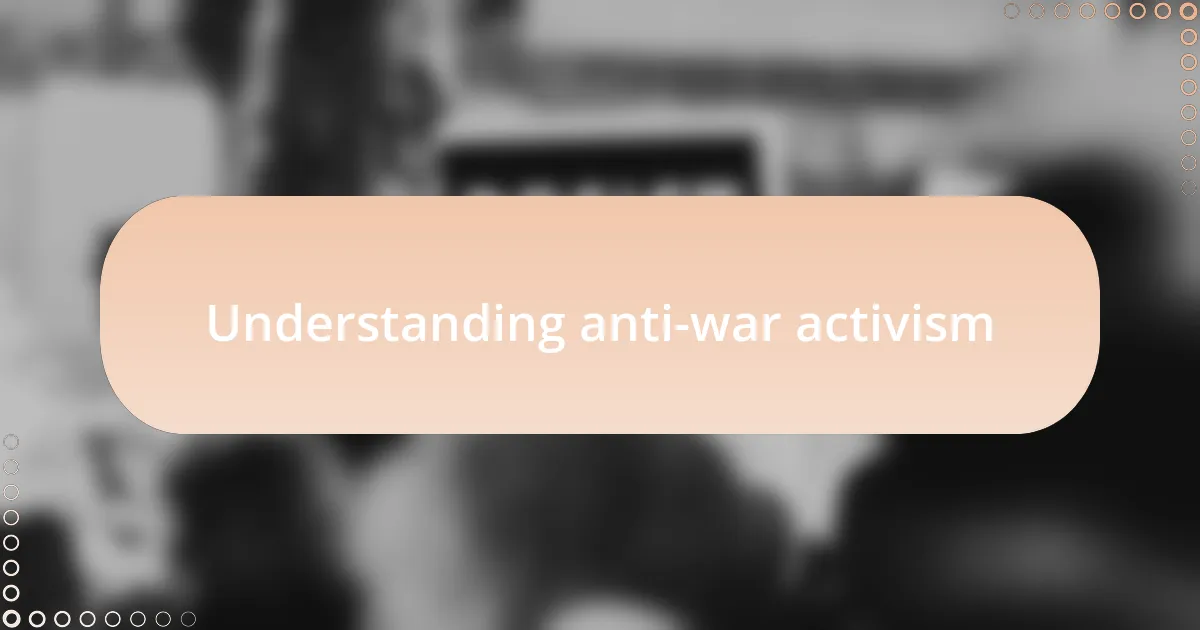
Understanding anti-war activism
Anti-war activism is a movement rooted in the belief that conflicts should be resolved through dialogue and understanding rather than violence. I remember the first time I truly grasped this concept during a local peace rally. The palpable energy in the air, filled with hopeful chants and passionate speeches, opened my eyes to the profound impact of collective voices united against war.
To many, the term “anti-war activist” may evoke images of protest signs and marches. However, it encompasses much more—it’s about advocating for human rights, challenging governmental policies, and fostering compassion in times of conflict. Have you ever found yourself questioning the reality of war and its consequences? I often reflect on the devastating stories of families torn apart, and that’s what fuels my passion for this vital cause.
Understanding anti-war activism requires us to look beyond the immediate actions of protesters. It demands that we consider the complex socio-political factors driving war, as well as the personal sacrifices made by individuals who dare to oppose the status quo. I’ve met countless activists whose lives were changed by the loss of friends or family members, and their stories of resilience and hope continue to inspire my own journey in this movement.
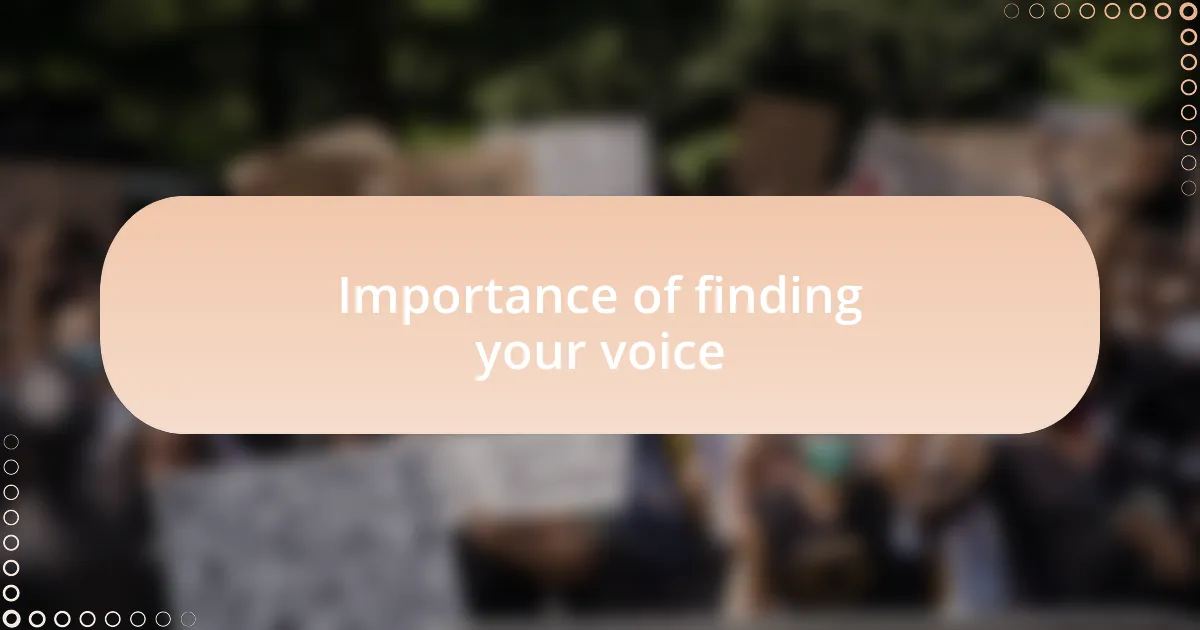
Importance of finding your voice
Finding your voice is crucial in anti-war activism because it allows you to express your unique perspective and experiences. I vividly remember standing in front of a crowd for the first time, my heart racing but my message clear. It was in that moment I realized that my personal story, intertwined with the broader narrative of war and peace, could resonate with others and inspire them to join the cause.
When you discover your voice, you also empower others to speak out. I often think about a fellow activist who shared her journey of losing a loved one in conflict. Her courage to share such a personal story encouraged many of us to reflect on our own experiences with war. Doesn’t it feel empowering to know that by simply sharing your truth, you can create a ripple effect in your community?
Moreover, finding your voice fosters authenticity in our activism. I have noticed that once I embraced my vulnerabilities—my fears and frustrations—I connected more deeply with others. Have you felt that same connection? Being authentic not only strengthens our message but also builds trust and solidarity among people fighting for the same cause.
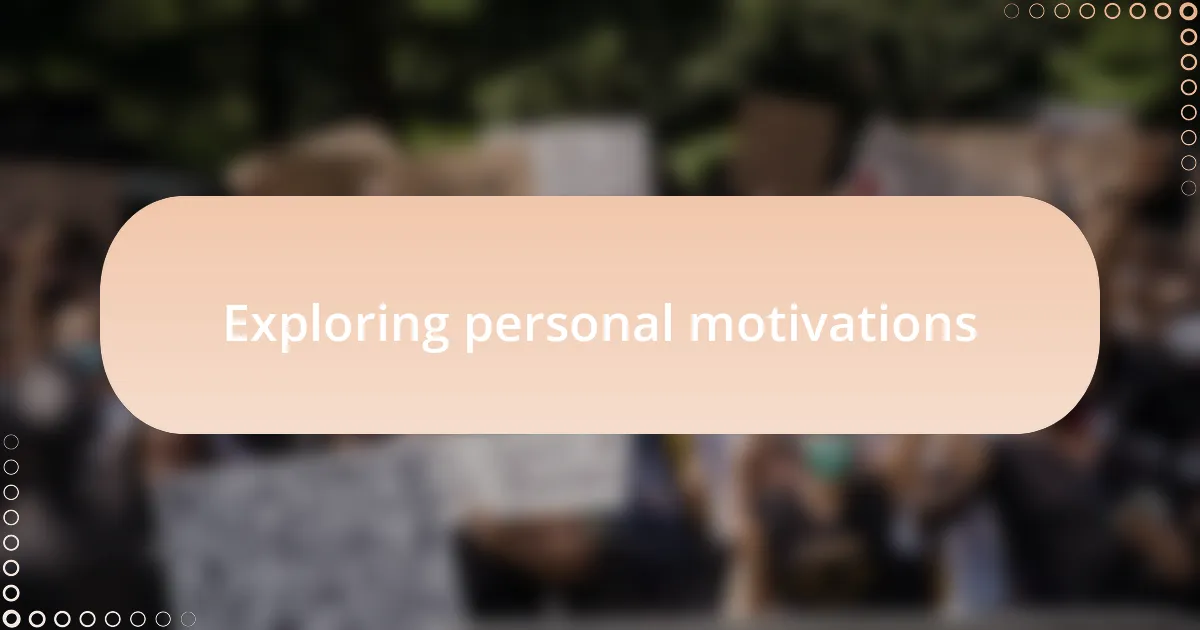
Exploring personal motivations
Understanding what drives me to speak out against war has been a transformative journey. I recall a quiet evening when I stumbled upon a documentary about the impact of conflict on families. As I watched the faces of children torn apart by violence, their anguish pierced my heart. In that moment, I realized my motivation wasn’t just about opposing war; it was deeply rooted in compassion and a desire for a world free of suffering.
Each experience I encountered contributed to shaping my advocacy voice. I often reflect on the conversations with friends whose lives were affected by war, hearing their stories ignited a fire within me. Have you ever felt that spark? For me, those discussions became a catalyst, compelling me to raise awareness. I found a sense of responsibility to not just listen, but to ensure their voices were amplified.
As I’ve navigated my advocacy path, I’ve discovered that my motivations often intertwine with hope and resilience. During a local rally, I met a veteran who shared how the horrors of war haunted him yet sparked his commitment to peace. Listening to him, I felt a profound connection, realizing our shared human experience drives the quest for change. This taught me that personal motives are often intertwined with the collective memory of pain and the unwavering desire for a better future.
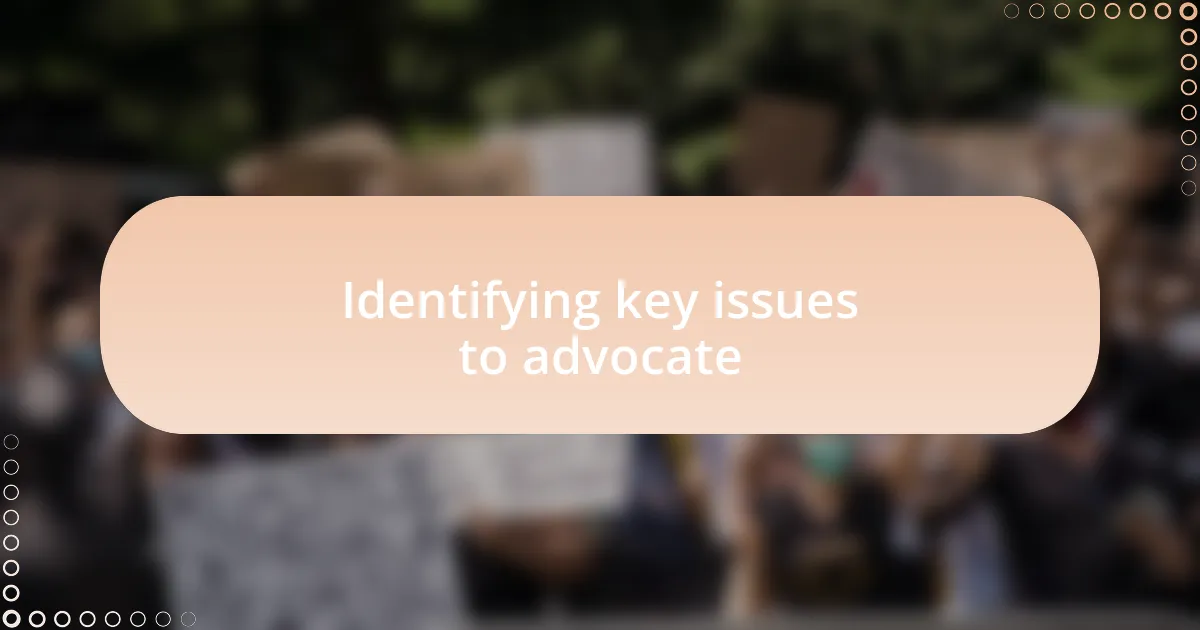
Identifying key issues to advocate
Identifying key issues to advocate can often feel overwhelming, but I’ve learned that focusing on personal experiences makes this process clearer. For instance, attending a community meeting after witnessing local families displaced by war ignited my passion for refugee rights. Seeing their struggle up close made me question how I could support those individuals and led me to prioritize advocacy around human rights for those affected by conflict.
Thinking back on the time I joined a peaceful protest, I remember the diverse voices I encountered, each sharing their unique reasons for standing up against war. This gave me insight into the various facets of the anti-war movement, from environmental impacts to the rights of marginalized communities. I wondered: how many of us take the time to understand the interconnectedness of these issues? Realizing that these topics often overlap inspired me to advocate for a more holistic approach, including how war disproportionately affects vulnerable groups.
I’ve also found that engaging with literature and art related to war can reveal critical issues to voice. One poignant book I read emphasized the psychological wounds caused by conflict, which resonated deeply with me. It made me question how often we consider mental health in discussions about war’s consequences. This exploration opened up yet another avenue for advocacy that I had not previously recognized, carving out a space for dialogues about healing and resilience in the aftermath of violence.
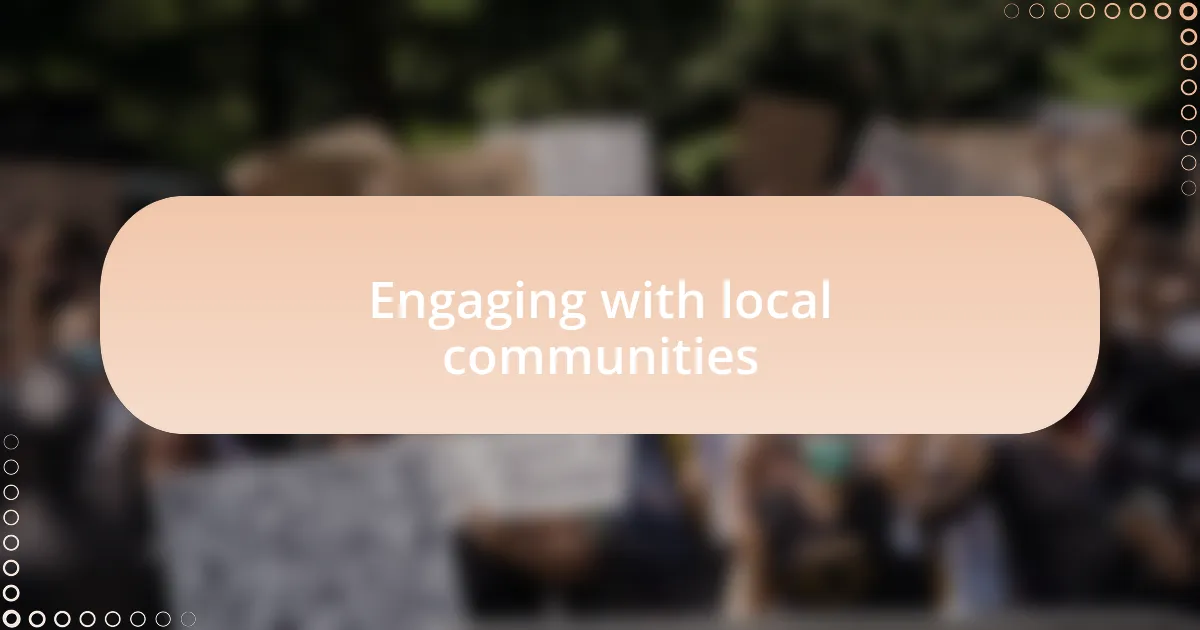
Engaging with local communities
When I first decided to engage with local communities, it didn’t happen overnight. I vividly recall attending a neighborhood gathering, where I shared my thoughts on the impact of war. The honest exchanges I had with neighbors opened my eyes. Their stories added depth to my understanding of conflict’s effects. Isn’t it powerful how stories can connect us on such a profound level?
As I continued to participate in community events, I felt an undeniable sense of belonging. I remember one particular afternoon spent volunteering at a local refugee support center. Hearing firsthand accounts from families who had fled violence was a transformative experience for me. I found myself asking, how could I amplify their voices while providing tangible assistance? This realization pushed me to consider the ways I could contribute meaningfully, not just through words but through action.
Sometimes, it’s the small interactions that leave the biggest impressions. During a community clean-up day, I struck up a conversation with a fellow volunteer who had lived through a civil war. His reflections on loss and resilience made me reconsider the importance of unity in our advocacy efforts. Couldn’t we all strive for a world where understanding and compassion replace conflict? Engaging with my community not only enriched my advocacy journey but also deepened my commitment to being a part of the solution.
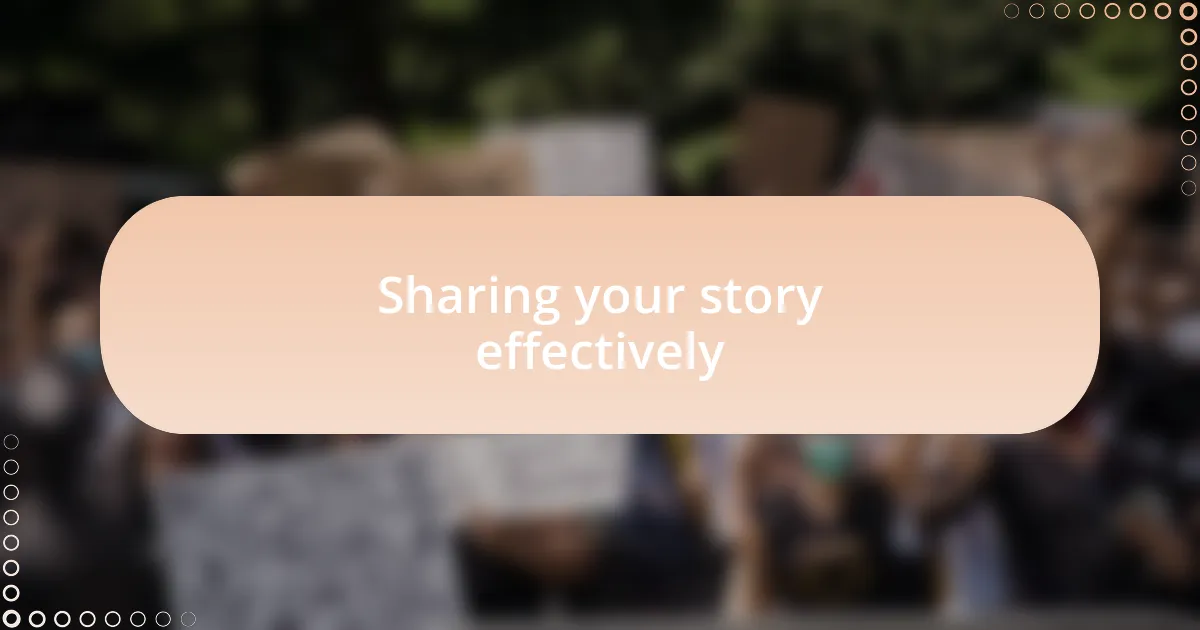
Sharing your story effectively
Sharing your story effectively is about more than just the words you choose; it’s about the emotional resonance behind them. I recall standing in front of a small crowd at a local event, sharing my own experience of attending a rally that was more than just a protest—it was a moment of solidarity. The tears in my eyes and the tremor in my voice seemed to draw the audience closer, each person feeling the weight of my journey. Have you ever noticed how vulnerability can create a bridge between hearts?
To truly connect, I’ve learned that the details matter. During a discussion panel, I painted a picture of a silhouette against a war-torn landscape, describing the palpable fear and hope mingling in the air. My intention was to allow others to visualize and feel the emotions tied to those scenes. How often do we overlook the power of imagery when sharing our narratives? The truth is, when people can see themselves in our stories, advocacy becomes a shared journey rather than a solitary path.
Incorporating a call to action can elevate your narrative immensely. After recounting a particularly harrowing experience from my volunteer days, I urged listeners to join me in writing letters to their representatives. It was a simple act, but the urgency in my voice transformed passive listening into active engagement. When was the last time your story inspired someone to take action? I’ve come to realize that sharing isn’t just about inspiring empathy; it’s about igniting a fire for change.
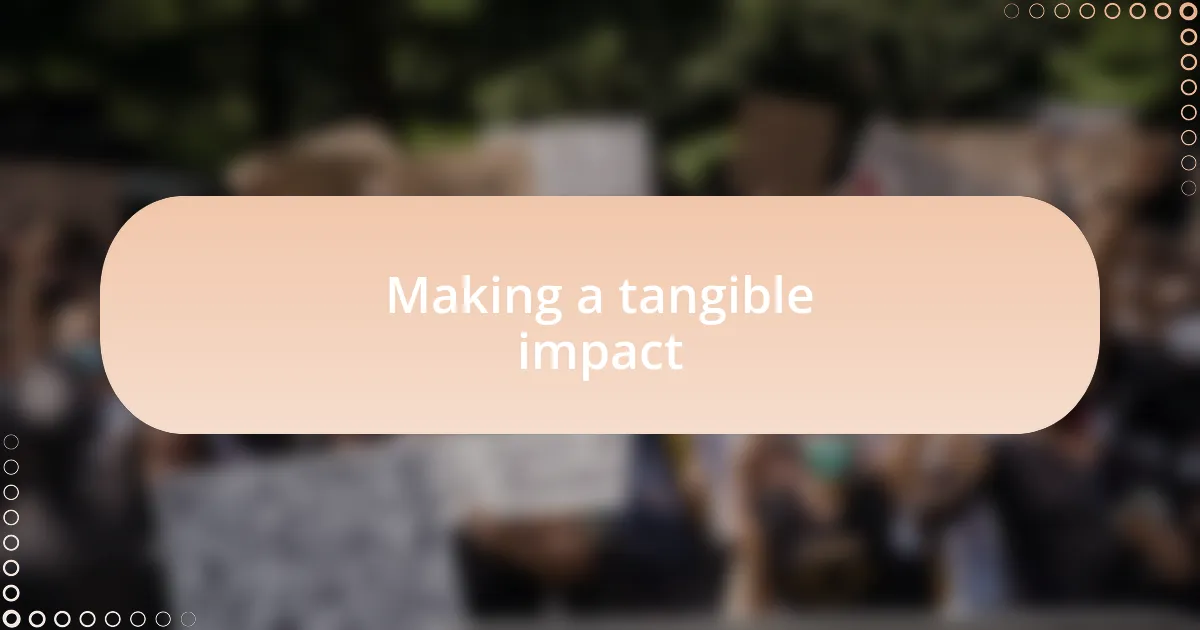
Making a tangible impact
Making a tangible impact goes beyond words; it’s about actions that resonate deeply within our communities. I remember one particular weekend when I organized a small art exhibition featuring pieces created by local artists depicting the effects of war. The turnout surpassed my expectations. People were not just viewing the art; they were sharing their feelings, sparking conversations that I hadn’t anticipated. Has a piece of creativity ever moved you to action in a way you didn’t think possible?
Another experience that shaped my advocacy was the time I collaborated with a group to host a community workshop on conflict resolution. Participants shared their stories, revealing how the heavy burden of violence touched their lives. I’ve seen firsthand how offering a safe space for dialogue can empower individuals, transforming collective pain into a shared mission for peace. What if, like me, you could create a platform where voices are heard and hopes are nurtured?
Finally, I’ve found that leveraging digital platforms can significantly amplify our impact. After I shared a video recounting my journey in activism, it caught the attention of people far beyond my immediate circle, inspiring others to join the cause. The ripple effect was remarkable, as countless viewers began their own campaigns. Isn’t it amazing how a single story can ignite countless others? I’ve learned that each step we take can create waves of change, making our efforts resonate in ways we might never fully comprehend.